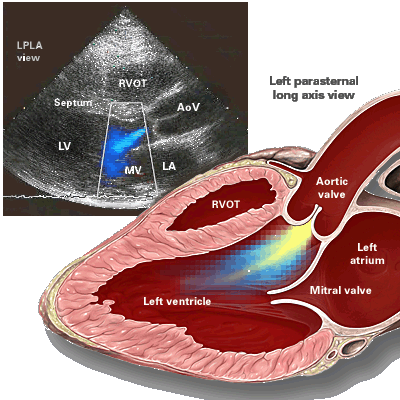Aortic regurgitation symptoms
| Resident Survival Guide |
| Aortic insufficiency | |
| Classification and external resources | |

|
|---|
|
Aortic Regurgitation Microchapters |
|
Diagnosis |
|---|
|
Treatment |
|
Acute Aortic regurgitation |
|
Chronic Aortic regurgitation |
|
Special Scenarios |
|
Case Studies |
|
Aortic regurgitation symptoms On the Web |
|
American Roentgen Ray Society Images of Aortic regurgitation symptoms |
|
Risk calculators and risk factors for Aortic regurgitation symptoms |
Editor-In-Chief: C. Michael Gibson, M.S., M.D. [1]; Associate Editor(s)-in-Chief: Cafer Zorkun, M.D., Ph.D. [2]; Varun Kumar, M.B.B.S.; Lakshmi Gopalakrishnan, M.B.B.S.; Rim Halaby, M.D. [3]
Overview
The symptoms of acute aortic regurgitation (AR) include dyspnea, chest pain (if aortic dissection is the cause of AR), weakness, and symptoms of congestive heart failure. Chronic AR may be asymptomatic for several years until there is a decrease in the stroke volume and cardiac output due to heart failure progression. Symptoms of chronic AR include exertional dyspnea, orthopnea, paroxysmal nocturnal dyspnea, and palpitations.[1]
History and Symptoms
Acute Aortic Regurgitation
In acute severe AR, there is a sudden decrease in the stroke volume and increase in left ventricular end diastolic volume and left ventricular end diastolic pressure which manifests as either sudden and severe dyspnea and/or chest pain (if aortic dissection is the cause of AR). Based on the history and symptoms, the cause of the acute symptoms can be suspected.
Type A Aortic Dissection
- Chest pain
- Sudden onset
- Intense
- Tearing and sharp
- Worse with deep breath or cough
- Relieved by sitting upright
- Unexplained syncope
- Previous history of:
Infective Endocarditis
- Persistent fever
- Previous positive blood culture
- High risk factors:
- Pre-existing cardiac abnormality
- Prosthetic valve
- Recent surgical or medical procedures
- Intravenous drug use
- Recent bacterial infection
- History of previous endocarditis
Symptomatic Severe Chronic Aortic Regurgitation
- Previous history of aortic valve disease
Chronic Aortic Regurgitation
In chronic AR, patients are usually asymptomatic for many years as the stroke volume is maintained by increased force of left ventricular contraction secondary to increased left ventricular preload as explained by Frank-Starling mechanism. With the progression of AR, the compensatory mechanisms begin to fail causing gradual enlargement of the left ventricle, thereby progressively increasing the left ventricular end diastolic pressure as well as decreasing the stroke volume and the cardiac output leading to left ventricular failure that manifest as: [1]
- Dyspnea on exertion
- Orthopnea
- Paroxysmal nocturnal dyspnea
- Palpitations (due to compensatory tachycardia)
- Chest pain (if left ventricular end diastolic pressure compromises coronary perfusion)
Once symptoms arise, cardiac function usually worsens more rapidly and mortality may exceed 10% per year.
Pertinent Elements in the Past Medical History
The following are some important elements in the past medical history of a patient with suspected aortic regurgitation.
- Cardiac disease
- Rheumatic fever
- Pulmonary disease
- Trauma
- Syphilis
- Ankylosing spondylitis
- Acromegaly
- Marfan syndrome
- Ehlers-Danlos syndrome
- Giant cell arteritis
- Takayasu's arteritis
- Previous cardiac surgery
References
- ↑ 1.0 1.1 van der Steen DA, Hulsbergen-Zwarts MS (2016). "[A woman with palpitations, dyspnoea and a heart murmur]". Ned Tijdschr Geneeskd. 160: A9696. PMID 26883843.